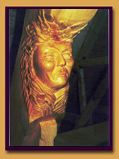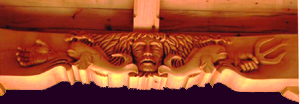|

Working with wood comes naturally to Paul Cottle. His intricate carvings
of flowers and leaves spring to life at his touch. Influenced by the works of 17th century woodcarver, Grinling Gibbons, "who
gave wood the loose and airy lightness of flowers," Paul strives to communicate something of himself in every piece he creates.
"Everyone has a different idea of how they perceive an object," says Paul. "Most of us can visualize an oak leaf,
but because there are many different types of oak leaf and a variety of seasons in which the oak leaf changes, which is the
right one to choose?" In this way, he says, each of his pieces tells a story. "Why did I do a leaf that way? Why did I choose
that wood? When I begin a carving, I try and interpret what is in the wood. This allows me to make it into a leaf, a scroll
or whatever it strives be."
Paul runs his business, Wood Spirit Design Studio, out of a workshop on his property in
London, Ontario. Unlike his Baroque predecessors, he utilizes modern technology in his work. Rather than toiling with chisel
and knife, he power carves using Foredom and Dremel manufactured tools. Because of this, Paul's medium is not restricted to
the softer woods. He can also carve a full range of hardwoods and especially enjoys working with poplar, basswood, cherry,
white oak, mahogany, walnut and hickory. The power tools allow greater freedom of movement, lessening the restrictions caused
by the vagaries of the grain. His resourcefulness has allowed him to take power carving to a higher level with his invention
of specific finishing tools.
Amazingly, this master carver is completely self-taught. Like Gibbons, Paul comes from
England, immigrating to Canada with his family in 1987. Here his passion for wood carving first found expression. He began
by sculpting design elements in beams for timber frame homes. It was a steep learning curve, in more ways than one, as the
beams are carved on location, using scaffolding and a steady hand. There are no second chances when the beams are already
an integral part of the structure!
While working on the beams, Paul became interested in carving other architectural elements. In the years since, he has designed
and carved panels in staircases, balconies, newel posts and fireplace mantels from six feet by nine feet to soaring structures
28 feet high and 12 feet wide. His pieces run the gamut from massive, decorative columns to delicate wall mounted oak leaves
and coy table top squirrels. His subjects range from rustic to sacred to contemporary. Today his repertoire includes an impressive
variety of works that are proudly displayed by collectors in Canada, Japan, Russia, Europe and the United States. They form
an integral design element in dwellings that range from timber frame cottages to an 8,500 square foot ultra modern home.
Just as the dimension and character of the carvings vary, Paul creates a boundless assortment of designs. His ideas come
not only from an intuitive understanding of the wood, but from gaining thoughtful insight into his clients' visions. His creations,
he says, must be done with the clients in mind, understanding and visualizing their dreams. "When the clients call and
say they want a mantel or stairs, they have already thought of the fact they want something unique in their house and have
spent the time searching out someone who will do something different," he says.
At this point in the process, Paul's role becomes that of a trusted confidante. His beguiling, gallant manner encourages
people to be candid and to articulate their dreams and desires.

For Sandy Pinney, those dreams centred on the southwestern U.S.A.. Says Pinney, "Paul carved a mantle for the great room
of our home in Kilworth. Most of the mantle is of cherry with a small portion being of basswood. When he came to the house
to discuss the design, I happened to being a T-shirt that I had purchased in Arizona. He looked at my T-shirt and said 'What's
wrong with what's on your shirt?' As it was one of my favourites, I thought it would be a great idea, so he went ahead with
the design. I 'took the shirt off my back' and we gave him several photographs of places from the southwest."
The resulting mantle has cliff dwellings, cactus, gravestones from Boothill and other items specific to the southwest.
The piece of basswood is a steer's skull, mounted in the centre front of the mantle.
"The client is the one who drops the pebble in the pond," Paul says. "From that initial contact starts
the creative process. I must discern as much as possible about them and what they are expecting of me in order to understand
what they want to achieve. I class myself as an intermediary between their ideas and the wood. In some cases, the client has
a love of nature and the mantel or the stairway would reflect wildlife or perhaps they have an appreciation for fantasy and
a penchant for dragons. Anything is possible."
Working with the clients' concepts, Paul creates an image that will tell the story of their vision. He likes his designs
to formulate a scenario, a feeling that the carving has been somewhere or is going to do something. Perhaps it carries a secret
that is left to the client to decipher.
Since the majority of his work is for the home, it tends to take on a personal quality. Paul feels that not only is he
making a unique artistic contribution to the home's design, he is creating history. "A lot of people want to have the
memory of building their dream home. They clear the ground, they build the house and they start a history. They want to signify
that their story has continuity."

Copyright 2004
Website created by
|